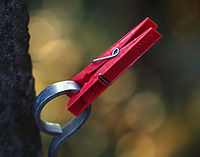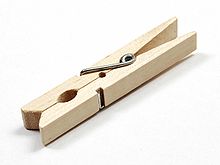- Clothespin
-
A clothespin (also clothes peg, or just peg) is a fastener used to hang up clothes for drying, usually on a clothes line. Clothespins often come in many different designs.
Contents
Design
The one-piece wooden clothes peg was created by Jérémie Victor Opdebec. This older design does not use springs, but is fashioned in one piece, with the two prongs part of the peg chassis with only a small distance between them—this form of peg creates the gripping action due to the two prongs being wedged apart and thus squeezing together in that the prongs want to return to their initial, resting state. This form of peg is often fashioned from plastic, or originally, wood. In England, clothes peg making used to be a craft associated with gypsies, who made clothes pegs from small, split lengths of willow or ash wood.[1]
Today, many clothes pegs (also clothes pins or pegs) are manufactured very cheaply by creating two interlocking plastic or wooden prongs, in between which is often wedged a small spring. This design was invented by David M. Smith of Springfield, Vermont, in 1853.[2] By a lever action, when the two prongs are pinched at the top of the peg, the prongs open up, and when released, the spring draws the two prongs shut, creating the action necessary for gripping.
Other uses
- A clothespin can be used for closing a bag, allowing opening easier than with a knot in the (plastic) bag, a piece of rope with a knot, etc.
- Clothespins with springs used to fascinate young children and served as raw material for various contraptions: fire-throwing catapults, mousetraps, pistols, detonators, not to mention various Rube Goldberg machines.
- Clothespins are sometimes used as playing pieces in games of skill or chance, such as Peg in the bottle.
- People put a clothespin on their nose, because they think it will slim and make their nose pointier.
- Clothespins are also sometimes used to pinch the nose so that one does not have to do it with one's hand because there is a really bad smell in the air.
- Clothespins were also used to attach baseball cards to bicycle forks such that the cards contacted the wheel spokes, making a motor sound as the wheel rotated.
- In BDSM, clothespins are frequently used as nipple clamps.
- The little person one drags around in Google Street View is called "pegman", because he is shaped like a clothes peg.[3]
- Clothespins which something is written on can be used as a memorandum. This is used in Peg DHCP (but this is April Fools' Day RFC).
Public art
One famous clothespin is this sculpture by Claes Oldenburg, entitled Clothespin. It is in Philadelphia across the street from the City Hall, and can be seen in the movie Trading Places.[4]
There is a 5-foot clothespin grave marker in the Middlesex, Vermont, cemetery.
Filmmaking
During the production of a movie, commercial, music video etc., a spring-type clothespin is called a "CP 47", "C47", "47", "peg", "ammo", or "bullet". It is most useful on the set since lights used on film sets quickly become far too hot to touch; a wooden C47 is used to attach a color correction gel or diffusion to the barn doors on a light.[5] The wooden clothes-pins do not transmit heat very effectively, and therefore are safe to touch, even when attached to hot lights for a significant period of time. Plastic or metal clothes pins are not used as plastic would melt with the heat of the lights and metal would transfer the heat making the clothes-pin too hot to touch. People like gaffers, grips, electricians and production assistants may keep a collection of C47’s clipped to clothing or utility belt at all times.[6] Hence the nickname "bullet", as so many crew members clip a number of C47s to their utility belts, much like an old west gunslinger would carry extra cartridges (which are often inaccurately referred to as bullets) on his gun belt.
When a talent is in full makeup they some times can not drink from a cup so they drink from a straw. When the bottle or cup is too deep for the straw a C47 is clipped an inch from the top of the straw to keep the straw from falling into the drink.
The name "C47" may have come from an attempt to make it sound less mundane than a clothespin, or it may have come from the label on the bin used to store them in an early studio.[7] More commonly believed is that the name "C47" came to be the designation that the clothespins were given when printed on studio budgets to trick budget managers into approving the request for them. A "C74", "74C", or "A47" is a clothespin that has been taken apart, reversed, and put back together so that the small end comes together. This gives a tweezer-like tool, useful for a task such as pulling a scrim from a hot light.[5]
Lutherie
Clothes pegs are often used to glue on kerfing during the production of guitars, mandolins and other stringed instruments.[8][9][10]
References
- ^ Crafts
- ^ The Better Clothespin
- ^ http://maps.google.com/intl/en_us/help/maps/streetview/behind-the-scenes.html#pegman
- ^ Alice L. George (2006) Philadelphia: A Pictorial Celebration. Sterling Publishing Company, Inc., p. 112. ISBN 1-402-72384-9
- ^ a b Box, Harry (1993) (1st ed). Set Lighting Technician's Handbook. Focal Press. p 141, 347, 349. ISBN 0-240-80161-X.
- ^ Rahmel, Dan (2004) Nuts and Bolts Filmmaking: Practical Techniques for the Guerilla Filmmaker Focal Press. p. 196. ISBN 0-240-80546-1
- ^ Uncommon Goods Uncommon Knowledge Retrieved July 14, 2006.
- ^ http://rosenbladt-guitars.com/shopdetail/the_body.html
- ^ http://norsewoodsmith.com/aggregator/categories/6
- ^ http://www.osborneatelier.com/Dulcimer_06.htm
External links
Categories:- Fasteners
- Laundry
- Domestic implements
Wikimedia Foundation. 2010.






